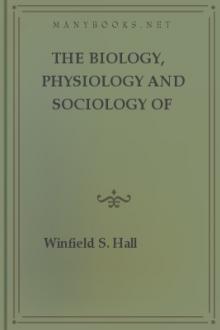The Biology, Physiology and Sociology of Reproduction, Winfield Scott Hall [latest ebook reader txt] 📗

- Author: Winfield Scott Hall
- Performer: -
Book online «The Biology, Physiology and Sociology of Reproduction, Winfield Scott Hall [latest ebook reader txt] 📗». Author Winfield Scott Hall
When the ovum reaches the finished state, which is called "maturity," it leaves the ovary, and is carried along the fallopian tube (see accompanying figure) into the uterus, where it usually finds a lodgment in the upper part, as shown in Figure I. Once the minute ovum has been caught in the projections of the velvety inner surface of the uterus, this thick velvety lining of the uterus in the neighborhood of the ovum begins a rapid growth, gradually enveloping the rapidly expanding ovum, as shown in Figures I and II of the accompanying plate.
Within the ovum there are taking place some of the most marvelous changes in the whole life history of the individual. The nucleus of the fertilized egg, and the protoplasm which surrounds it, divide into two cells, then into four, eight, sixteen, etc. These divisions follow each other in such rapid succession that there are many hundreds of cells by the end of the first twenty-four hours. These cells soon begin to arrange themselves into layers and groups, which, step by step, develop the different tissues and organs of the body.
By the end of thirty days the little embryo, about as large as one inch of the end of a lead pencil, would be recognized as the embryo of some mammalian animal, but it would be quite impossible to say whether it would develop into a human being or some other animal, if it were seen quite apart from its immediate surroundings. By the end of another thirty days, however, the little embryo has multiplied its size several times, and has reached a form instantly recognizable as the young of the human kind, as shown in Figure IV. It still, however, retains the vestige of a little tail, which within the next thirty days will have been completely absorbed.
THE FEMALE ORGANS OF GENERATION
Note that the little two months embryo has projecting from its abdomen a large structure which is labeled "cord." This cord is a part of what is called the umbilical cord, and it is this that joins the embryo to the mother. Note in Figure III the large stalk of this cord passing upward from the body of the embryo and merging into the structures in the top of the uterus. Note further that there are little branching structures passing from the base of this stalk up into the base of the uterus. These branching structures are loops of blood-vessels, and they form part of the placenta, or "afterbirth." Through this cord the embryo receives its nourishment from the mother. The blood of the mother bathes these loops of blood-vessels, and the embryo absorbs from the mother's blood the nourishment which builds its bones, muscles, brain, spinal-cord, and glands. From the same source the embryo receives the oxygen necessary for the maintenance of its life.
From the third month on to the end of the nine months, the amount of material which the mother must provide for the development of the child within her womb amounts to no small draft on her physical resources. It is not at all uncommon for a mother in the later months of pregnancy to become quite pale, her blood having been impoverished to provide material for the development of her child.
What has been said above regarding the contributions which the maternal organism must make toward the development of the offspring must have impressed on the mind of the reader that maternity means, first of all, sacrifice.
This sacrifice begins when the girl first enters upon womanhood.
With the expulsion of the ripened ovum comes, each month, a week of special physical drain, when work must be lightened and vigorous exercise curtailed, when exposure to cold or dampness may mean loss of health.
Under these circumstances a woman should at this time deny herself the pleasure of dancing; of skating or swimming; of sleigh-rides or cross-country walks and the young man should make it less difficult for her by acquiescing without question or demur in her request to be excused from such recreation.
It is a fact that more sacrifice is involved in maternity among the more highly cultivated nations of the human race than is true of aboriginal peoples, or among the lower animals. Conditions of modern life, and particularly urban life, leave the female organism less able to endure the drafts made upon the system by maternity, so that to bear a child may mean not only the sacrifice of comfort, but even the sacrifice of health.
The highly sensitive, delicately adjusted nervous system of the woman is perhaps more profoundly influenced than any other part of her being. This manifests itself particularly in a heightened degree of sensitiveness. It goes without saying that the pregnant woman deserves at the hands of all who come in contact with her, and particularly at the hands of her husband, most considerate and sympathetic treatment. Her little whims and vagaries, however unreasonable, must always be treated seriously, and with delicate and tactful consideration. The members of her family, particularly the husband, owe it to her and to her child to keep her in as happy a frame of mind as possible.
When we consider the real significance of maternity to the race, to society, and to the family, we must feel that, of all human relations, maternity is the most sacred, and that no condition should be allowed to mar it, and no consideration to take precedence of it.
After the husband had contributed the male sexual cells, or spermatozoa, in this wonderful process above outlined, it might seem that there is little he can do, except to wait, while nature carries on the process. The reader will remember, however, from the chapter on Reproduction, that the contribution of the spermatozoa only initiates the sacrifices that the paternal organism must make in this process. Are there any demands on paternity between the time of conception of the new life and its birth?
As already mentioned under the preceding topic, the pregnant mother needs gentle and loving care. She needs to have her little whims and foibles overlooked. She needs to be protected, so far as possible, from every influence that might depress or make her unhappy. She needs to be guarded against any unusual physical exertion, and above all, she needs at this time more than at any other time, the manifested affection and sympathy of her husband.
There is another sacrifice, if it may be so called, which the husband is called upon to make during the pregnancy of his wife, namely, to abstain absolutely from sexual intercourse during the period of pregnancy and for two or three months following. This means practically one year of continent living. All other animals observe this period of continence. Nature demands that man observe it in common with other animals. Man is the only animal that has transgressed this fundamental law of nature. The retribution which nature metes out to the transgression of this law is various. Sometimes, but rarely, the sexual excitement on the part of the woman may cause an abortion, or a miscarriage. The more usual result makes itself manifest in the drain on the nervous energy of the woman. When we consider that maternity in the human race involves greater sacrifice than in any other animal, it would seem that the addition of this last demand, namely, of satisfying the sexual desires of the husband during the period of pregnancy, might prove "the straw that breaks the camel's back," and result in the more or less complete nervous breakdown of the woman. The author submits this question to all fair-minded men: Is it not due to the wife that she be not asked to satisfy the recurring sexual desires of the husband during the period when her life and its energies are so sacred to the race, to society, and to the family?
The author submits this question because some men are known to transgress this law of nature. Fortunately the proportion of men who thus transgress is not large.
Let us stand for these things: (1) An equal standard of purity for men and women, (2) A strenuous, virile, continent manhood, (3) Sexual temperance in wedlock.
Personal conferences and correspondence with young men regarding the solution of their problems have brought out several questions that are so frequently repeated as to make it evident that the answering of them would serve the purpose of clearing up certain questions or doubts, more or less important in the minds of many young men. It has been decided to group these answers in an appendix rather than to incorporate them in the body of the book, as many of them seem not quite relevant to the topics outlined under the several chapters.
1. How do we know that during the nocturnal emission the products of the testes are not present?
The spermatozoa found in the nocturnal emission, if present at all, are found to be very much less active than the spermatozoa of semen secreted during sexual excitement. The seminal vesicles are not receptacles for the testicular secretion. The ampullæ seem to serve that purpose in a limited degree.
Considering all these facts, it seems to be a tenable conclusion that the few and sluggish spermatozoa seen in the product of the nocturnal emission are those that have, from time to time, collected in the ampullæ, and that during the time immediately preceding the nocturnal emission the testes are not actively releasing nascent spermatozoa. This function of the testes seems to be reserved for periods of conscious sexual stimulation.
2. How may one control too frequent emissions?
If emissions are too frequent for the individual case, they are followed by depletion and malaise. Even if they occur as infrequently as once in two weeks and are followed by the above symptoms, they must be considered as too frequent, or abnormal in that case. On the other hand, they may occur as frequently as twice a week in plethoric robust individuals, and especially in men who have had frequent sexual intercourse, and who have for some reason discontinued it. And even though they occur as frequently as twice a week, if they are followed by a feeling of relief and wellbeing, they must not be considered as too frequent for that individual under the conditions.
So the frequency limit of nocturnal emissions is more or less independent of the time and quite dependent upon the reaction of the individual to the emission. If, following the criterion above outlined, one finds that his emissions are too frequent, because of accompanying depletion and malaise, this frequency may be modified either by changes of the diet or by changes of hygiene.
For a more extended discussion, see text above on nocturnal emissions.
3. Do the organs of reproduction actually develop after the age of seventeen or nineteen or even to the twenty-fifth year as is the case with the physical and mental powers?
The brain of an individual adds no nerve cells after a very early age. The brain increases only very slightly in size and weight after the age of puberty, and then only under special conditions and this increase in weight and size is not due to the addition of any new cells, but simply to a slight increase in the bulk of those cells already present. In a similar way the sexual apparatus undergoes, during the period of puberty (fifteen to seventeen) a very rapid growth, reaching by the end of the period of puberty (seventeenth or nineteenth year) their full size.
4. Are enlarged veins in the scrotum dangerous?
Enlarged veins of the scrotum represent dilatation of the veins





Comments (0)